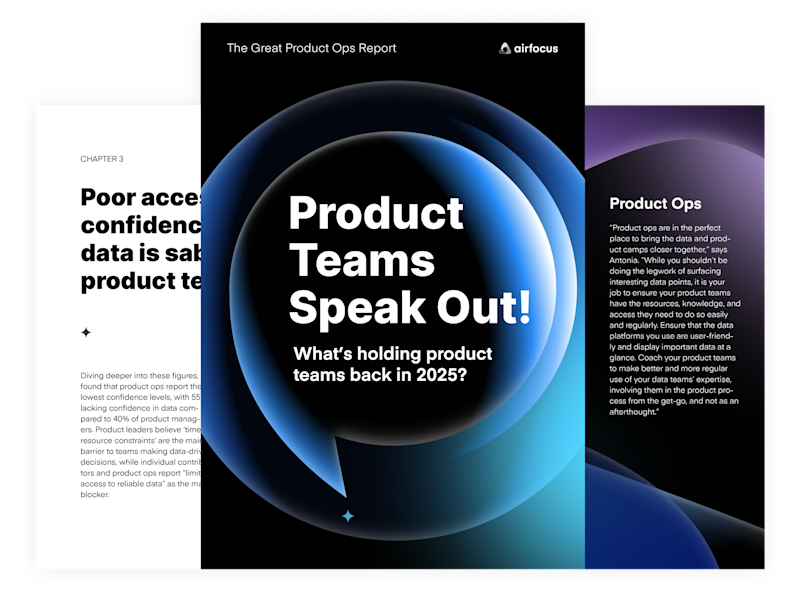
Product operations (Product Ops) has solidified its role as a game-changer in product management. It’s no longer a question of whether you need product ops, it’s about how well you’re leveraging it. In a recent webinar featuring Antonia Landi, a leading voice in the product ops space, and Malte Scholz, CEO and CPO of airfocus, we discussed the transformative power of product ops and how modern tools like airfocus can supercharge its potential.
In this article, we will share the key insights from our discussion, including practical tips, data-driven insights, and how airfocus empowers product ops and product teams.

TL;DR
Product ops consolidates scattered tasks, creating clarity and driving efficiency.
Its main goal: enable teams, improve collaboration, and empower decision-making.
Customer centricity and data-driven insights are at the core of product ops success.
airfocus offers tools to centralize feedback, build customizable workflows, and prioritize effectively.
Product ops thrives on pragmatism, relationship building, and empowering teams.
To stay ahead, focus on collaboration and use metrics like feature adoption to measure success.
Why product ops matters
Let’s start with the basics. Product ops didn’t create new responsibilities, it streamlined existing ones. By consolidating scattered tasks like tool management, workflow optimization, and data analysis, product ops allows organizations to focus on what truly matters: creating great products.
It’s the difference between firefighting mode and having a proactive, holistic overview of your organization’s work processes, Antonia said.
Product ops doesn’t just improve efficiency; it also fosters collaboration.
According to the 2023 State of Product Ops Report, by the Product-led Alliance 74% of respondents highlighted improved collaboration as a key benefit of the Product Ops function.
What makes product ops work?
The principles of product ops mirror those of strong product management. Think of it as the strategic glue holding your product ecosystem together.
Key principles of product Ops:
Enablement: 32% of respondents said the most important principle of product ops is enabling product teams (PLA 2023).
Collaboration: 91% of product ops professionals emphasize the importance of communication and cross-functional teamwork (PLA 2023).
Data-driven decision making: Analyzing data to inform product decisions ranked as the most critical function for 24% of respondents (PLA 2023).
While the principles remain consistent, their application varies by company size. For startups, product ops often lays foundational processes. For enterprises, it drives large-scale initiatives like tool migrations or cultural shifts toward experimentation and A/B testing.
Customer centricity: the core of product ops
One persistent challenge in product management is ensuring teams remain customer-centric. This is where product ops shines. By setting up systems for customer feedback, conducting user interviews, and making insights accessible, product ops ensures decisions are always grounded in customer needs.
However, it’s not just about collecting feedback, it’s about making it actionable.
You need systems that make customer insights findable and usable across the organization, Antonia emphasized.
How airfocus elevates product ops
A key takeaway from the webinar was how tools like airfocus can empower product ops teams. As a modular and highly customizable platform, airfocus is designed to help teams centralize feedback, prioritize tasks, and streamline workflows, all while adapting to your organization’s unique needs.
Why airfocus is perfect for product ops
Centralized feedback management
Use airfocus Insights to collect, analyze, and prioritize feedback from multiple sources, including social media, Slack, and customer portals.
Powerful roadmapping
Build roadmaps with multiple views and templates that cater to diverse stakeholders. Whether you’re dealing with tech-savvy product managers or less technical executives, airfocus makes it easy to communicate priorities. Check out Antonia Landi's Idea capture & roadmap prioritization template created for airfocus here.
Customizable workflows
Product ops teams can strategize tasks, create workflows, and ensure alignment across cross-functional teams.
Collaboration at scale
With integrations for popular tools like Jira, Slack, and Microsoft Teams, airfocus ensures seamless communication between departments.
Data-driven prioritization
Leverage frameworks like OKRs or Priority Poker to score initiatives and align them with strategic goals.
Automation for efficiency
Automate notifications, feedback intake, and reporting to save time and keep everyone in the loop.
Real-world impact
According to the 2023 State of Product Ops Report, 62% of respondents agreed that product ops is extremely important to the product development process. Tools like airfocus help teams not only measure success but also amplify it, with metrics like feature adoption rates (52% agreed it was the most important) becoming easier to track.
Curious about how airfocus can fit into your product ops strategy? Book a demo and see how it can transform your team’s workflows.
Overcoming challenges in product ops
Despite its potential, product ops can face resistance. Some organizations struggle with change, while others don’t yet measure the success of their product ops function.
41% of companies surveyed by Product-Led Alliance in 2023 didn't have any metrics to measure the success of the product ops function.
As Antonia pointed out:
You can’t force change. Product ops relies on relationship building and introducing systems that make sense for the people who’ll live with them.
The solution? Start small, focus on quick wins, and build momentum. Tools like airfocus can help you tackle immediate challenges while setting the stage for long-term impact.
Product ops as a coach
One of the best analogies from the webinar likened product ops to a personal trainer.
It’s not just someone who writes your training plan. It’s the coach who shows up every week to ensure you’re doing the work that leads to excellence, Malte explained.
In the same way, product ops ensures teams follow best practices, fosters collaboration, and removes barriers to success.
The idea capture & roadmap prioritization template
During the webinar, Antonia and Malte provided a detailed walkthrough of the Idea Capture & Roadmap Prioritization Template, designed to help product teams centralize insights, prioritize effectively, and deliver impactful outcomes.
This template consists of two interconnected workspaces:
Idea backlog:
A repository for collecting, refining, and organizing ideas from stakeholders, customers, or teams. It leverages custom fields to capture essential details, such as target audience, problem definition, and potential revenue impact, ensuring that only high-quality, actionable ideas move forward.
Initiative prioritization & roadmap workspace:
Where ideas are transformed into initiatives, prioritized using scoring frameworks, and visualized in dynamic roadmaps tailored to different stakeholders.
Key features of the template
Streamlined feedback intake: The template simplifies how organizations collect, process, and prioritize feedback, using tools like forms and integrations with platforms like Slack or Microsoft Teams.
Data-driven decision making: Insights from the Idea Backlog feed directly into roadmap prioritization, giving teams the clarity to focus on initiatives with the greatest impact.
Custom views & reports: Tailored views help product teams and stakeholders focus on relevant data and track progress in real time.
Antonia emphasized the importance of this template as a practical tool for product-led organizations striving for alignment and efficiency. She noted that while the template is comprehensive, its modular design allows teams to customize it to fit their unique workflows.
Curious to try it out? This template is now available in the airfocus template library and can be a starting point for transforming your product ops workflows.
Take action
Want to deep-dive into what's holding product teams back? The Great Product Ops report gathers insights from 169 product professionals, including leaders, team managers, and product ops specialists, to uncover what’s really holding product teams back in 2025. Featuring expert insights from consultant Antonia Landi, Richard Humphrey (Contruent), and Ken Thompson (Buildkite), this report doesn’t just reveal the product team challenges - it provides practical solutions to help product teams thrive.

Conclusion
Product ops is no longer optional, it’s essential for organizations striving for product excellence. By focusing on enablement, collaboration, and customer-centricity, product ops transforms the way teams work. Tools like airfocus make this transformation not only possible but seamless, giving teams the flexibility to create workflows that work for them.
As the statistics show, product ops isn’t just about processes, it’s about empowering teams to deliver better products. Ready to level up? Book a demo today and see airfocus in action.
Additional resources
Antonia Landi's Idea capture & roadmap prioritization template for airfocus
Our eBook: How Product Ops Can Significantly Reduce the Friction Of Your Team

Nouran El-Behairy

Read also





Experience the new way of doing product management

Experience the new way of doing product management


